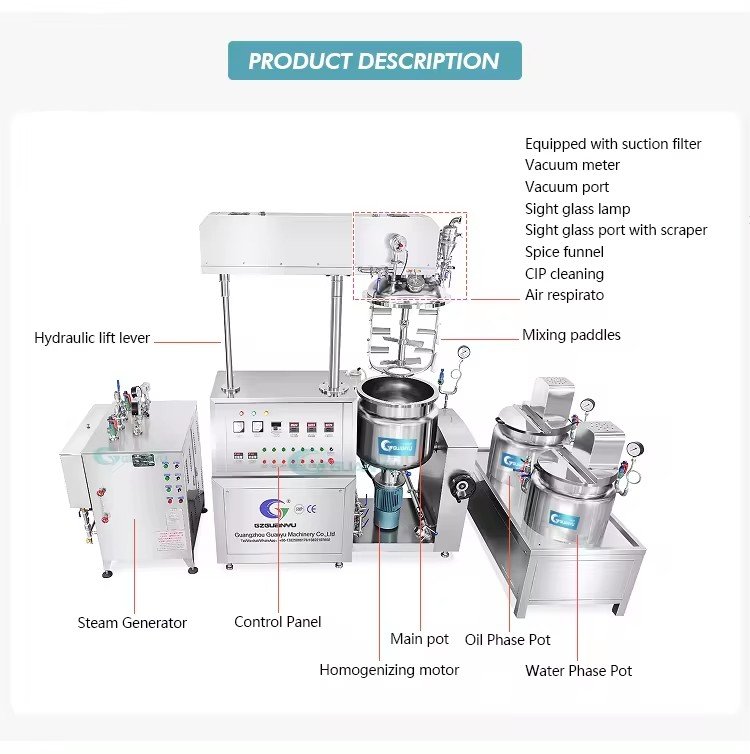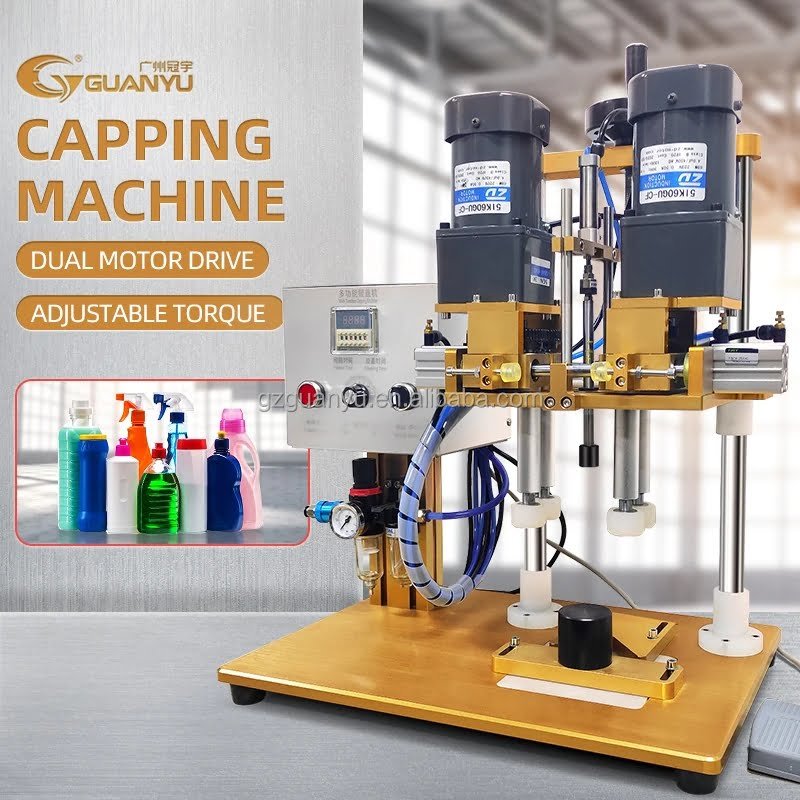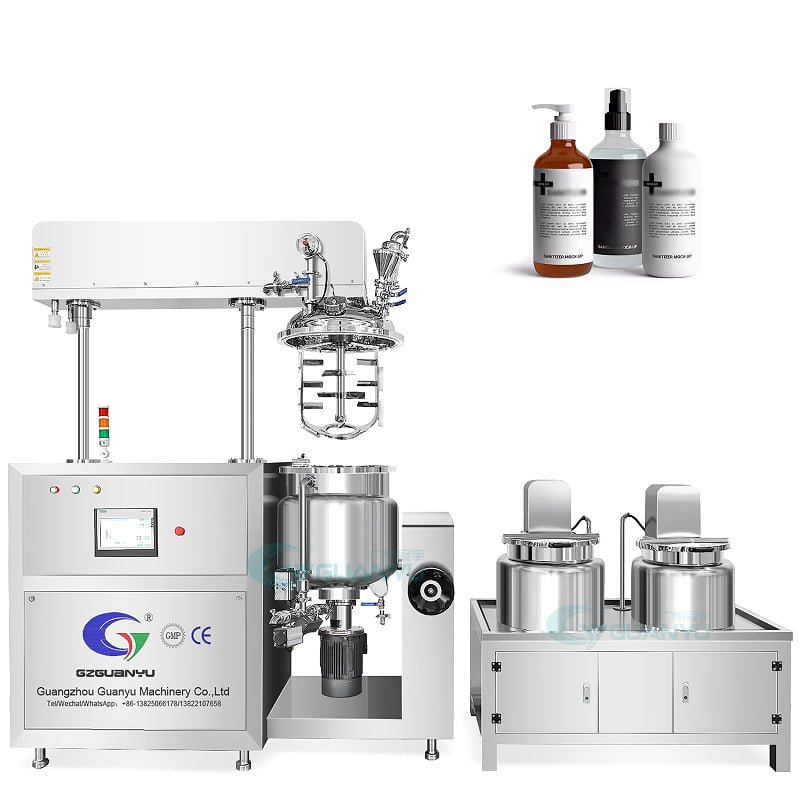什么是乳化机?
乳化机在多种产品的生产中发挥着至关重要的作用, 从食品和化妆品到药品和化学品. 这些专用乳化机旨在通过彻底混合两种或多种不混溶的液体来形成稳定的乳液, 例如油和水.
乳化机的目的是将一种液体的大液滴分解成更小的液滴, 均匀分散在另一种液体中的液滴, 产生均匀稳定的混合物. 此过程对于创造具有理想质感的产品至关重要, 外表, 和保质期.
有多种类型的乳化机可供选择, 每个都有其独特的特点和功能. 一些最常见的类型包括高剪切乳化机, 胶体磨, 和超声波乳化机.

高剪切乳化机和低剪切乳化机有什么区别?
高剪切乳化机结合高速旋转和专用叶轮,产生强烈的剪切力,快速将大液滴分解成更小的液滴. 这会产生具有更均匀粒径分布的更细乳液. 高剪切乳化机通常用于生产低粘度乳液, 例如个人护理产品和某些食品应用中的成分.
相比之下, 低剪切乳化机依赖于更温和的混合动作, 例如慢速搅拌或简单的螺旋桨叶片, 形成乳液. 这些机器通常会产生具有更广泛液滴尺寸的较粗乳液. 低剪切乳化机更适合高粘度产品, 例如面霜和软膏, 过度剪切可能会损坏敏感成分.
乳化机如何工作?
这些乳化机进行的乳化过程基于流体动力学和表面化学原理. 乳化机的关键部件包括混合室, 转子-定子组件, 以及速度等各种可调参数, 温度, 和处理时间.
乳化过程中, 两种不相溶的液体 (通常是油相和水相) 被引入混合室. 然后转子-定子组件向混合物施加高剪切力, 将一种液体的较大液滴分解成较小的液滴, 均匀分散在其他液体中的液滴. 这是通过强烈的机械搅拌的结合来实现的, 湍流, 并在室内产生高压梯度.
乳化机的可调参数, 比如转速, 温度, 和处理时间, 可以仔细控制以优化不同产品配方和所需特性的乳化过程. 通过操纵这些参数, 制造商可以实现所需的液滴尺寸, 粘度, 和最终乳液的稳定性.
乳化机的应用
乳化机广泛应用于各个行业, 每个都有其独特的要求和规格. 一些关键应用包括:
食品饮料行业
在食品和饮料领域, 乳化机用于为蛋黄酱等产品创造稳定的乳液, 沙拉敷料, 调味料, 冰淇淋, 以及各种乳制品. 乳化过程有助于实现所需的质地, 口感, 以及这些产品的保质期.
化妆品和个人护理产品
乳化机在化妆品和个人护理产品的生产中发挥着至关重要的作用, 比如乳液, 面霜, 药膏, 和防晒霜. 乳化过程确保活性成分均匀分布, 油类, 和水性成分, 产生具有理想感官特性和稳定性的产品.
医药化工
在制药和化学工业中, 乳化机用于制造药物输送系统的乳液, 药膏, 以及各种特种化学品. 受控乳化过程有助于提高生物利用度, 稳定, 以及这些产品的功效.
选择合适的乳化机
为特定应用选择合适的乳化机需要仔细考虑各种因素, 比如产量, 产品粘度, 所需粒径, 以及行业的具体需求.
选择乳化机时, 必须咨询经验丰富的制造商和供应商,以确保所选设备满足应用的独特要求. 他们可以提供有关各种机器类型的指导, 他们的能力, 以及最适合所需产品的配置.
真空乳化机有哪些不同类型?
真空乳化机是一种特殊类型的乳化机,在减压下运行. 这些机器旨在生产空气含量较低的乳液, 从而提高产品的稳定性, 质地, 和保质期.
一些常见类型的真空乳化机包括:
真空均质机: 这些机器结合使用高速转子-定子组件和真空系统来产生具有最少空气掺入的精细乳液.
真空搅拌机: 这些机器在真空条件下采用慢速搅拌来轻轻混合和乳化成分, 常用于高粘度产品,如面霜和软膏.
真空脱泡乳化机: 这些机器具有高剪切乳化和真空系统,可去除乳液中的空气, 生产更稳定、一致的产品.
真空乳化机的选择取决于具体的产品要求, 所需的乳液特性, 和产量.
安装与维护
乳化机的正确安装和维护对于确保其长期性能和最佳产品质量至关重要. 安装机器之前, 准备场地很重要, 确保有足够的空间, 公用事业, 和环境控制措施到位.
安装过程中, 乳化机必须适当调平, 连接到电源和公用设施, 并根据制造商的说明进行校准. 应进行彻底的测试和验证,以确保机器按预期运行.
乳化机的持续维护也至关重要. 这包括定期清洁, 检查, 并按照制造商的建议更换磨损部件. 维护活动的正确记录和记录有助于防止意外故障并确保符合行业标准和法规.
法规遵从性和安全性
乳化机的使用须遵守各种行业标准和法规要求, 取决于具体应用和地理位置. 制造商和运营商必须确保其设备和工艺符合相关安全要求, 质量, 和环境法规.
乳化机的常见行业认证和标准包括 CE 标志, FDA 批准, 并遵守良好生产规范 (良好生产规范) 指导方针. 适当的安全功能, 比如守卫, 紧急停止, 和降噪措施, 还必须到位以保护操作员并确保安全的工作环境.
此外, 乳化过程中产生的废物的处理, 以及机器运行对环境的影响, 应仔细考虑和解决,以尽量减少制造过程的生态足迹.
故障排除和常见问题
乳化机, 像任何复杂的机械一样, 偶尔会遇到问题或故障. 常见问题可能包括乳液质量不一致, 泡沫过多, 机器停机时间, 以及内部组件的磨损或损坏.
乳化机故障排除时, 遵循结构化方法至关重要. 这可能涉及审查操作参数, 检查磨损或损坏, 并向机器制造商或合格的维修技术人员咨询. 维护机器性能和遇到的任何问题的详细记录也可以帮助诊断和解决问题.
预防性维护, 定期校准, 遵守最佳实践有助于最大限度地降低常见问题的风险,并确保乳化机的长期可靠运行.


哇,正是我一直在寻找的东西. 通过搜索nordvpn优惠券来到这里inspiresensation (92网址.com) 特别优惠券代码
2024
出色的工作! 这是应该在网络上共享的信息.
搜索引擎感到羞愧,因为它不再将这个提交定位在更高的位置!
快来咨询我的网站 . 谢谢=)
我的网站 Eharmony 特别优惠券代码 2025
您好,您介意分享您正在使用哪个博客平台吗?
我计划很快开始自己的博客,但我很难在 BlogEngine/Wordpress/B2evolution 和 Drupal 之间做出决定.
我问的原因是因为你的设计看起来不同
然后大多数博客和我都在寻找完全独特的东西.
P.S 我很抱歉偏离主题,但我不得不问!
看看我的网页: VPN
与书本相比,在网上很容易找到任何主题, 当我发现这块
在此网站上撰写. https://tinyurl.com/28555853 游戏蝇
这些实际上是关于博客的绝妙想法.
你在这里接触到了一些令人愉快的因素. 不管怎样继续写.
什么是VPN连接 https://tinyurl.com/2ytofo73
一般来说我不学习在博客上发帖, 但我想说这篇文章
非常迫使我看一看并这样做! 你的写作
味道让我惊讶. 谢谢, 非常好的帖子.
是的! 最后一些关于VPN的事情.
这些实际上是关于博客主题的奇妙想法.
你在这里触及了一些挑剔的东西. 不管怎样继续写.
https://tinyurl.com/yneylc4d eharmony 特别优惠券代码 2025